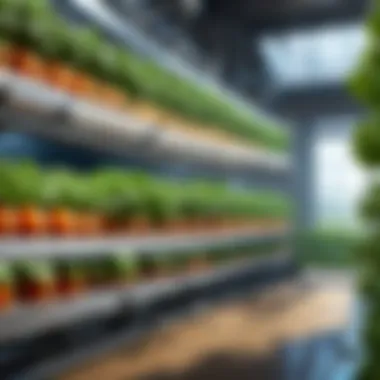Innovative Farming Practices for Sustainable Agriculture


Intro
Innovative agricultural practices are redefining how we approach farming. This article takes you through various methods that integrate technology, sustainability, and biodiversity. As the world faces increasing challenges like climate change and population growth, it's essential to explore these practices. In this discussion, we cover precision farming, agroecology, vertical farming, and community-supported agriculture. Each method offers unique solutions that can increase productivity while maintaining the ecological balance. By understanding these innovations, we can work towards a more resilient agricultural sector.
The following sections delve into key strategies and emerging trends shaping the future of farming. We will highlight the relevance of these methodologies in modern agriculture, aiming to engage readers who are keen to deepen their understanding of these practices.
Precision Farming
Precision farming refers to the use of advanced technologies to enhance crop yields and reduce waste. This approach leverages tools such as GPS, soil sensors, and data analytics. Farmers can gather real-time data about their fields. By analyzing this data, they adjust their farming techniques accordingly. This not only optimizes the use of resources but also reduces environmental impact.
For example, farmers can apply fertilizers only where needed, cutting down on excess runoff into waterways. This method promotes sustainability while increasing profitability. Moreover, the precision agriculture sector is constantly evolving, contributing to ongoing advancements in sustainable farming.
Benefits of Precision Farming
- Resource Efficiency: Better use of water, seeds, and fertilizers.
- Higher Productivity: Increased crop yields from optimized farming practices.
- Environmental Protection: Reduced chemical runoff leads to a healthier ecosystem.
Agroecology
Agroecology emphasizes the ecological processes that underpin agriculture. Instead of relying solely on technology, this method looks towards nature for sustainable solutions. Crop rotation, intercropping, and organic fertilization are core practices here. These techniques allow farmers to maintain soil health and combat pests naturally.
Additionally, agroecology can foster biodiversity within farming systems. Practicing agroecological methods supports local wildlife, which helps in pest control and pollination.
Key Principles of Agroecology
- Diversity: Cultivating a variety of crops enhances resilience.
- Cycles: Utilizing natural cycles to minimize dependence on inputs.
- Interactions: Fostering positive interactions between components of the farming system.
Vertical Farming
Vertical farming represents a radical shift in how we think about space and agriculture. By stacking layers of crops in controlled environments, urban areas can produce food sustainably. This model minimizes land use while maximizing output. Technologies like hydroponics and aeroponics make this method viable.
Urban centers can benefit greatly from these farms. Transport costs are reduced, and food freshness is improved. Furthermore, vertical farming can mitigate the effects of climate change by reducing the carbon footprint associated with agricultural practices.
Advantages of Vertical Farming
- Space Efficiency: More food can be grown in smaller areas.
- Resource Management: Less water usage compared to traditional farming.
- Food Security: Increased local food production reduces reliance on imports.
Community-Supported Agriculture
Community-supported agriculture (CSA) creates a direct link between farmers and consumers. This model encourages local food production while fostering community ties. Members of the community subscribe to receive regular portions of seasonal produce directly from local farms.
CSAs enhance food security by providing access to fresh, locally-grown produce. Additionally, they nurture relationships between consumers and farmers, promoting transparency in the food system.
Benefits of Community-Supported Agriculture
- Local Economies: Supports local farmers and keeps money within the community.
- Food Quality: Consumers receive fresh, organic products.
- Engagement: Strengthens the connection between agriculture and community health.
"Innovative agricultural practices not only enhance productivity but also promote ecological harmony."
Emerging Trends in Agriculture
The agricultural landscape is shifting rapidly. Trends such as digital farming, the use of artificial intelligence, and organic farming are becoming increasingly prevalent. Digital platforms are enabling farmers to access information quickly. And this can inform and improve their decision-making process.
Moreover, consumers are becoming more health-conscious. They are demanding sustainably produced food. Hence, many farmers are transitioning to organic methods. The growing awareness of food systems is shaping the future of agriculture.
By understanding these innovative practices, we pave the way for a sustainable and productive future in farming.
Preamble to Modern Farming
Modern farming reflects a transformation in agricultural practices. It is essential to highlight how these developments reshape our relationship with the land and food production. In the context of this article, understanding this evolution provides a foundation for appreciating innovative practices that will be explored later. Today, farming transcends traditional methods, leaning toward techniques that prioritize sustainability and productivity.
Understanding Agricultural Evolution
Agriculture has evolved significantly over millennia. The shift from hunter-gatherer societies to settled farming communities marks a pivotal change. Early agriculture relied heavily on rudimentary tools and techniques. As civilizations progressed, they developed more sophisticated farming methods.
The introduction of mechanization in the 19th century heralded a new era in agriculture. Tractors and other machinery transformed productivity. However, traditional practices often overlooked ecological balance and sustainability. This led to over-farming and depletion of soil nutrients.
In recent decades, there is increased awareness of these issues. As a result, modern farming practices emphasize not only efficiency but also ecological health. This evolution reflects a paradigm shift towards more sustainable and regenerative methods.
The Need for Innovative Practices
The urgency for innovative practices in agriculture stems from various global challenges. Growing populations, climate change, and diminishing natural resources all pose significant threats to food security. Innovative practices can mitigate these risks. They enhance productivity while ensuring ecological integrity.
Moreover, traditional farming methods are often unsustainable. Practices that worked in previous eras can no longer meet the demands of today. As soil degradation and water scarcity become pressing concerns, it is critical to explore new methodologies.


Innovative agricultural practices may foster resilience in food systems. Embracing technology, precision farming, and agroecology can optimize resource use and improve yield. Thus, governments, farmers, and communities must prioritize innovation to secure a sustainable future.
"Innovative and sustainable agricultural practices are vital for ensuring food security in an era of rapid environmental change."
Sustainability in Agriculture
Sustainability in agriculture is an essential concept that aims to support farming practices that can meet current and future food production needs. This focus helps to ensure that the environment is preserved for future generations, creating a balance between productivity and ecological health. With increasing concerns about climate change, deteriorating soil, and biodiversity loss, innovative sustainable practices are crucial.
Sustainable agriculture encompasses various methods that minimize environmental impact while maintaining farm profitability. This may include using natural fertilizers, crop rotation, and integrated pest management. The goal is to create a system that can endure and thrive over time, rather than one that depletes resources.
The relevance of sustainability in agriculture to this article lies in its role in promoting healthier farming practices. Transitioning to sustainable methods not only supports environmental conservation but also enhances food security. Farmers can increase their yield without destroying the ecosystems upon which our food systems depend.
Defining Sustainable Farming
Sustainable farming is defined by practices that are environmentally friendly, economically viable, and socially responsible. This term can refer to a wide range of methods, but some key principles include:
- Resource Conservation: Using resources wisely to avoid waste and reduce emissions.
- Biodiversity Promotion: Enhancing crop diversity to strengthen ecosystems.
- Soil Health: Implementing practices that improve soil structure and fertility.
- Water Management: Ensuring effective use of water resources to combat droughts.
The goal is to maintain the balance between current production needs and future resource availability. This requires continuous innovation and adapting to new challenges, but it ultimately leads to more resilient farming systems.
Benefits of Sustainable Agricultural Practices
Adopting sustainable agriculture comes with several notable benefits:
- Environmental Protection: Less reliance on chemical inputs reduces pollution and promotes ecological balance.
- Enhanced Resilience: Farms that embrace sustainable practices can better withstand climatic changes and extreme weather events.
- Economic Savings: While initial costs may be higher, long-term savings from lower input costs often balance this out.
- Community Health: Sustainable practices can lead to healthier food options, benefiting consumers and local communities.
"Sustainable agriculture is not a passing trend; it is a necessity for the preservation of our planet."
By transitioning to sustainable methods, we can create a agricultural system that benefits both farmers and the environment.
Further reading on sustainable practices can be found on Wikipedia or Britannica.
Technological Advancements in Farming
Technological advancements in farming play a crucial role in shaping the future of agriculture. These innovations address the critical challenges that traditional farming faces today. They enhance productivity, improve efficiency, and promote sustainability. By integrating modern technologies, farmers can make informed decisions and optimize resource use. This ultimately contributes to food security while minimizing environmental impact.
The Role of Precision Agriculture
Precision agriculture employs advanced technologies to monitor and manage field variability. It enables farmers to use precise amounts of inputs like water, fertilizers, and pesticides. This targeted approach improves crop yield, making agriculture more sustainable and economically viable.
Data Analytics
Data analytics involves collecting and analyzing data to make better decisions. It helps farmers track weather patterns, soil conditions, and crop health. One key characteristic is its ability to process vast amounts of data quickly. This speed is why data analytics is a valuable tool for farmers. It allows for timely interventions in crop management, thus increasing yields. However, implementing data analytics requires investment in technology and training, which can be barriers for some farmers.
Satellite Imaging
Satellite imaging provides a bird's-eye view of agricultural fields. It helps in assessing crop health and land use efficiently. Its key characteristic is the ability to cover large areas quickly and accurately. This feature makes satellite imaging a beneficial choice in modern farming. Farmers can identify areas needing attention without the need for physical inspection. However, the interpretation of satellite data can be complex, requiring skilled personnel.
Sensor Technology
Sensor technology involves devices that collect real-time data from the fields. This includes soil moisture levels, temperature, and other vital metrics. Its key characteristic is the real-time feedback it provides, helping farmers respond to conditions promptly. This immediacy makes sensor technology essential in precision agriculture. Yet, the cost of installing sensor systems can be a concern for small-scale farmers, promoting uneven technology adoption.
Automation and Robotics in Agriculture
Automation and robotics have transformed the way farming operations are carried out. These technologies reduce human labor and increase efficiency, allowing farmers to focus on higher-level strategic tasks.
Drones
Drones are aerial vehicles that assist in various agricultural processes. They are used for crop monitoring, spraying pesticides, and collecting data. A key characteristic of drones is their ability to capture high-resolution images of crops from the sky. This capability provides farmers with detailed insights into crop health and growth patterns. The advantages include reduced labor costs and improved accuracy, but regulatory challenges surrounding drone usage can be a drawback.
Automated Tractors
Automated tractors are equipped with advanced technology to operate independently. They can plant seeds, till soil, and perform other tasks without direct human control. The main characteristic is their ability to work continuously, which enhances productivity in farming. Automated tractors are a popular choice for modern farms aiming for efficiency. However, the high initial costs can be a significant barrier for many farmers.
Harvesting Robots
Harvesting robots are designed to autonomously gather crops. They use advanced sensors and algorithms to identify ripe produce. A key characteristic of these robots is their precision in harvesting, which reduces waste. They offer numerous advantages, including increased efficiency and reduced labor costs. Nonetheless, they may struggle with varying crop types or unforeseen obstacles in the field.
In summary, technological advancements in farming are pivotal in transforming agricultural practices. By adopting these innovations, farmers not only improve productivity but also contribute positively to sustainability efforts.
Agroecology: Blending Tradition and Innovation
Agroecology integrates the principles of ecology with agricultural practices. This approach emphasizes the synergy between traditional farming wisdom and scientific research. As the agricultural sector faces challenges such as climate change and biodiversity loss, agroecology stands out as a viable strategy. The blend of traditional knowledge and innovative practices promotes sustainable farming that respects natural ecosystems while ensuring food security.


What is Agroecology?
Agroecology encompasses a wide range of practices and principles aimed at making agriculture both sustainable and productive. In essence, it applies ecological concepts directly to the production of food and farming systems. Agroecology seeks to optimize interactions within agricultural systems, involving soil, plants, animals, and humans. It focuses on improving productivity while maintaining environmental health. The approach also values local knowledge and community participation, acknowledging that farmers often have insights into their local ecosystems that can lead to better practice.
Strategies for Implementing Agroecological Practices
Implementing agroecology requires a strategic approach that embraces both innovation and tradition. Here are some effective strategies:
- Diversification of Crops: Growing a variety of crops can lead to healthier ecosystems. Crop diversity improves soil quality and reduces the need for chemical inputs.
- Integrated Pest Management (IPM): Utilizing biological control methods helps maintain pest populations at manageable levels without harmful chemicals. This reduces the risk of pest resistance and promotes biodiversity.
- Agroforestry: Combining trees with crops or livestock creates more productive ecosystems. Trees provide shade, habitat, and nutrients while enhancing overall biodiversity.
- Cover Cropping: Utilizing cover crops allows for soil protection. These plants prevent erosion, enhance soil fertility, and even improve water retention.
"Agroecology not only supports sustainability but also enriches the relationship between communities and their food systems."
- Community Involvement: Engaging local communities can lead to more effective strategies tailored to specific areas. Collective knowledge often provides solutions that top-down approaches overlook.
Through these strategies, agroecology positions itself as a forward-thinking response to the challenges facing modern agriculture. It encourages practices that are sustainable and beneficial for both farmers and the environment. The ultimate goal is not only to meet current food demands but also to ensure future generations can thrive.
Vertical Farming: The Future of Urban Agriculture
Vertical farming has gained significant attention in recent years as a solution to the challenges posed by urbanization, climate change, and the growing demand for food. This method of farming is particularly important because it allows for increasing food production within constrained urban spaces. As cities expand, available land for traditional agriculture diminishes. Vertical farming systems utilize creative vertical arrangements to maximize yield per square foot and provide a sustainable approach to agriculture in crowded environments.
Overview of Vertical Farming
Vertical farming refers to the practice of cultivating crops in vertically stacked layers or integrated into other structures, such as warehouses or skyscrapers. This innovative approach often employs controlled-environment agriculture (CEA) technology, relying on soilless farming techniques like hydroponics and aeroponics. The systems can operate indoors, under artificial lighting, making it possible to grow food year-round, independent of seasonal variations.
One notable feature of vertical farming is its ability to reduce the transport distance from farm to consumer. With farms located in urban centers, the freshness of produce improves, and transportation emissions decrease. Moreover, controlling the growing environment means that urban farms can avoid pesticides and reduce water usage significantly, addressing some key problems in conventional agriculture.
Advantages of Vertical Farming Systems
Vertical farming systems offer numerous advantages:
- Space Efficiency: Utilizing vertical space means farms can produce more food in less area, which is crucial in city environments.
- Resource Conservation: These farms often use 90% less water than traditional farming and can recycle nutrients and water effectively.
- Reduced Transportation Costs: Proximity to consumers means fresher products and lower transportation costs, leading to decreased emissions.
- Pest and Disease Control: Controlled environments significantly limit pest exposure, reducing the need for chemical pesticides.
- Local Employment Opportunities: Vertical farms can create jobs in urban areas, contributing positively to local economies.
In summary, vertical farming presents a breakthrough in sustainable agriculture, enabling cities to produce their own food and mitigate the challenges posed by urban life.
As urban centers continue to grow, the importance of vertical farming becomes increasingly evident. It offers a practical answer to the food security issue while also minimizing environmental impact. As technology advances and public interest grows, this innovative agricultural practice could reshape our approach to food production.
Community-Supported Agriculture (CSA)
Community-Supported Agriculture represents a significant shift in the traditional agricultural model. This practice enhances the relationship between farmers and consumers by creating a direct connection that fosters community engagement and mutual support. As food production faces increasing pressures from environmental and economic factors, CSA serves as a viable alternative to conventional farming. It empowers local communities, encourages sustainable practices, and provides consumers with fresh, seasonal produce.
Understanding the CSA Model
In the Community-Supported Agriculture model, consumers purchase shares of a farm's harvest in advance. Shareholders receive regular distributions of fresh produce throughout the growing season. This approach allows farmers to secure upfront funding, reducing the financial risks associated with crop production.
The key elements of a CSA include:
- Subscription-Based Purchasing: Consumers commit to paying for a share of the harvest. This payment provides farmers with necessary funds for seeds, soil amendments, and labor.
- Shared Risk and Reward: Both farmers and consumers share the risks of crop failure or a bountiful harvest. This alignment fosters a community spirit.
- Focus on Local Produce: CSA members typically receive locally grown fruits and vegetables, which supports local economies and provides fresher options.
Benefits to Local Communities and Farmers
The benefits of Community-Supported Agriculture extend beyond the farm itself. Here are some key advantages:
- Economic Support for Farmers: By securing upfront payments, farmers are more financially stable and can invest in sustainable practices.
- Access to Fresh Produce: Consumers receive high-quality, fresh produce without long supply chains, reducing the carbon footprint associated with transportation.
- Fostering Community Engagement: CSA programs encourage community interaction through farm events, volunteering opportunities, and educational workshops.
- Promoting Biodiversity: Many CSA farms prioritize biodiversity by growing a variety of crops, which can improve soil health and ecosystem resilience.
- Health and Nutrition Awareness: Consumers gain insights into seasonal eating and the benefits of local foods, leading to healthier diet choices.
"CSA is not just about food; it’s about connecting communities and creating a sustainable food system."
Biodiversity and Crop Rotation
Biodiversity and crop rotation are two fundamental practices in modern agriculture that play a vital role in promoting sustainable farming. By focusing on these aspects, farmers can not only enhance soil health but also produce crops that are more resilient to pests, diseases, and climate variability. This section delves into the significance and implementation of these practices, providing insight into how they contribute to a better agricultural future.
The Importance of Biodiversity in Farming
Biodiversity refers to the variety of life forms within a given ecosystem. In farming, this concept expands to include crop diversity, livestock diversity, and the various organisms in soil. The significance of biodiversity in agriculture cannot be overstated. It is crucial for several reasons:
- Pest Management: A diverse ecosystem can help in natural pest control. Different crops attract various beneficial insects that prey on pests.
- Soil Health: Biodiversity in soil microbes contributes to nutrient cycling and organic matter decomposition. This directly impacts crop yield and soil fertility.
- Resilience: Diverse cropping systems are more adaptable to external shocks such as climate change and market fluctuations. They can better withstand any adverse effects, ensuring food security.
- Nutritional Value: Different crops carry varying nutritional profiles. A diverse diet improves public health, enabling communities to thrive.
Incorporating diverse species into farming practices fosters natural systems that support sustainable agriculture. The focus on biodiversity is more than just a trend; it’s a necessity for long-term agricultural success.
Implementing Crop Rotation for Healthier Soil
Crop rotation is the practice of alternating different crops in a specific sequence over multiple seasons. This system is critical for maintaining soil health and optimizing crop production. Here are some key points to consider:
- Nutrient Management: Different crops demand different nutrients. By rotating crops, farmers can prevent nutrient depletion. For instance, legumes, like peas and beans, enrich soil nitrogen levels, benefitting subsequent crops.
- Disease Prevention: Certain crops can harbor pests and diseases. Rotating to a different species disrupts the lifecycle of these pests and helps reduce their populations.
- Soil Structure Improvement: Various root structures influence soil structure differently. Deep-rooted plants can improve soil aeration and moisture retention, while shallower roots may enhance surface stability.
- Weed Control: Crop rotation can help in managing weed pressure, as different crops require different weeding strategies, thus reducing the prevalence of weed species.


By planning a crop rotation strategy based on local conditions, farmers can significantly improve their soil health and crop productivity.
"In agriculture, the myriad interactions between species create a tapestry of life that, when balanced, supports continuous productivity and resilience."
The Economic Impact of Innovative Farming
The economic impact of innovative farming methods extends beyond mere agricultural productivity. These practices, while enhancing yield and sustainability, also reshape the economic landscape of rural communities. Understanding how these innovations contribute to economic growth is vital. Economic gains include cost savings, value addition, and job creation within the agricultural sector. Moreover, as consumers become more environmentally conscious, demand for sustainably produced goods rises, presenting farmers with lucrative opportunities.
Cost-Benefit Analysis of Sustainable Practices
Conducting a cost-benefit analysis of sustainable practices in farming reveals the true value of these methods. Various studies show that initial investments in technologies such as precision agriculture and organic farming can lead to long-term cost reductions. These reductions come from resources saved through increased efficiency and reduced inputs like water and fertilizers.
Farmers can turn to practices like cover cropping, which minimizes soil erosion, thereby lowering the expense associated with soil rehabilitation. By tracking the economic performance of these sustainable practices, stakeholders can develop strategies that maximize both agricultural output and financial return on investment.
- Benefits of a Cost-Benefit Analysis:
- Identifies effective practices that yield the highest returns.
- Assesses environmental benefits alongside economic gains.
- Supports decision-making by offering quantitative data.
To solidify their position in a changing market, farmers must take this analytical approach seriously. Sustainable farming not only aligns with ecological stewardship but also makes economic sense.
Long-Term Financial Sustainability
Long-term financial sustainability is crucial for the future of agriculture. As the world faces challenges such as climate change and resource depletion, it becomes increasingly necessary for farming practices to evolve without compromising economic viability. This evolution is not merely about cutting costs; it involves building resilience in farming operations.
Farmers adopting innovative practices tend to experience improved soil health and biodiversity, leading to a more stable ecosystem. Healthy ecosystems can support consistent yields, ultimately protecting farmers against market fluctuations. Furthermore, access to federal subsidies for implementing sustainable practices may alleviate financial pressures, ensuring a stable income.
Points to consider for financial sustainability include:
- Crop Diversification: Reducing reliance on a few crops minimizes risk and allows adaptability to market conditions.
- Building Local Networks: Connecting with nearby suppliers and consumers can reduce transportation costs and improve cash flow.
- Investing in Technology: Utilizing advanced agricultural technologies can enhance productivity and profitability over time.
"Innovative practices in agriculture not only benefit the land but also secure the financial future of farming communities."
Challenges Facing Modern Agriculture
The agricultural industry faces numerous challenges that influence both its immediate practices and its long-term sustainability. Understanding these challenges is critical. It provides insights into why innovative practices are not just beneficial but necessary. The pressures of climate change, economic constraints, and social dynamics play a vital role in shaping agricultural outcomes.
Climate Change and Its Implications
Climate change stands as a towering obstacle to modern agriculture. With rising temperatures, changing precipitation patterns, and more frequent extreme weather events, the stability of agricultural systems is heavily compromised.
Farmers now experience altered growing seasons, making it difficult to predict harvest times. This unpredictability can lead to lower yields and food shortages. Moreover, pests and diseases may flourish in warmer conditions, presenting new threats to crops. The implications extend beyond just farming practices; they affect food security, rural livelihoods, and global markets. Addressing climate change requires a shift towards adaptive strategies. For instance, farmers may need to adopt resilient crop varieties or implement water-conserving techniques.
- Key Considerations:
- Understanding local climate patterns is essential.
- Investing in research for climate-resilient crops is vital.
- Collaboration at community levels can lead to effective local solutions.
"Climate change is not just an environmental concern; it fundamentally alters the economics of farming, pushing the need for innovation."
Economic Barriers to Adoption
Another significant challenge in modern agriculture is the economic barriers that farmers encounter. Transitioning to innovative practices often demands upfront investments for new technologies or sustainable methods. Smallholder farmers particularly struggle with this aspect. They may lack access to financing, which is essential for adopting advanced farming techniques.
The cost of switching to organic practices or precision farming equipment can be daunting. The return on investment is often uncertain and may take years to materialize, discouraging many from making necessary changes. Supporting policies should therefore focus on providing financial incentives and education to ease this transition.
- Strategies to Mitigate Economic Barriers:
- Government subsidies for adopting sustainable practices.
- Access to microloans for small farmers.
- Partnerships with NGOs to provide training and resources.
Farmers must navigate these economic challenges to achieve long-term sustainability, highlighting the importance of accessible solutions.
Future Trends in Farming
In the realm of agriculture, the continuous quest for advancement is vital. As global needs evolve, so must farming practices. Future trends define the principles and pathways that will shape the agricultural landscape for decades to come. Innovating in farming is not only a matter of improving productivity but also involves addressing sustainability challenges, economic viability, and environmental impacts. By understanding these trends, stakeholders can make informed decisions that align with the changing dynamics of the industry.
Emerging Technologies
Emerging technologies play a crucial role in transforming agricultural practices. The integration of technology is reshaping the way farming is conducted. Notable advancements include:
- Artificial Intelligence: With AI, farmers can analyze large data sets. This technology enhances decision-making, optimizing crop yield and managing resources efficiently.
- Internet of Things (IoT): IoT devices help in monitoring environmental conditions in real time. Sensors in the fields provide critical data on soil moisture, weather patterns, and crop health.
- Genetic Engineering: Crop modification leads to varieties that can withstand pests and diseases. This can significantly reduce losses and impacts on food supply.
- Blockchain: Enhances transparency in the supply chain. It ensures consumers can trace the origin of their food, promoting trust and accountability.
The implementation of these technologies can accelerate progress towards efficient and sustainable farming operations. However, it is crucial to balance tech integration with ecological considerations to avoid unintended consequences on ecosystems.
The Role of Policy in Agricultural Innovation
Policies significantly influence the agricultural landscape. Effective governance can promote innovation or create barriers. Key elements include:
- Funding and Grants: Government support through financial incentives can encourage research and development in agriculture. Programs that provide subsidies to adopt new technologies can boost farm productivity.
- Research and Development Initiatives: Collaborations between governments and research institutions can foster innovation. This can lead to breakthroughs in sustainable practices and crop resilience.
- Regulatory Frameworks: Clear and supportive regulations help navigate the complexities of adopting new farming practices. They can address issues regarding safety, environmental impact, and ethical considerations in genetics.
Continued dialogue among policy makers, farmers, and industry leaders is essential. All parties must collaborate to create a framework conducive to innovation. Balancing the interests of various stakeholders can lead to practices that benefit both the environment and agriculture.
"Farmers must adapt to changes, but policies must evolve too for a better agricultural future." - Anonymous



